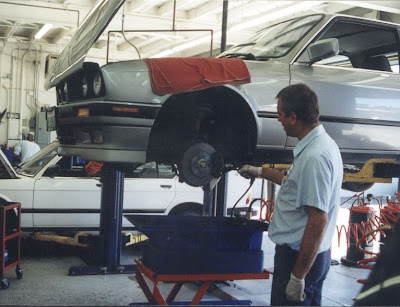When is it time to upgrade?
I remember the first car my wife and I bought in 1993. It was a faded silver 1984 Mazda 323 with six figure mileage already. We called it the "Ole Gray Mare," as in the classic song with the lines: "...she ain't what she used to be."
My wife and I were newlyweds, recently graduated from college, and both engaged in nonprofit leadership. The Ole Gray Mare was all we could afford.
But it wasn’t long before we realized that she was quite expensive in her own way. The brakes went bad. The AC went out. As novice car buyers, we had forgotten to notice how worn out the tires were when we first purchased the car. A burning smell seemed to plague our drives and stubbornly remained undiagnosed.
In the waiting room of our mechanic were many dog eared copies of People. I read them all. Twice.
Within a couple of years, we were trapped in that no man’s land of used car owners: suspended between paying for that next repair or anteing up a large sum for a truly reliable new car.
This uncomfortable place defines the existence of many resource constrained organizations. Their leaders constantly wrestle with questions such as:
-
Should we keep running down to Kinko’s or bite the bullet and finally get our own color copier?
-
Can we get by with our occasional volunteer bookkeeper or do we need a more rigorous accounting system?
-
When do you need to move from making personnel decisions on the fly to a formal HR handbook?
-
Would hiring a professional grantwriter actually get us those big foundation grants?
-
When does your donor database outgrow your homegrown Excel spreadsheet?
These aren’t easy questions to answer. They can especially be painful for organizations that are doing good. The needs of the homeless, the environment, the foster children can all seem more deserving and urgent than one’s office equipment. Funders reinforce this bias by preferring funding requests that flow to program delivery versus organizational infrastructure.
Each situation is of course unique and defies any strict formula. But economists have noted that in these kinds of matters, people do not easily make the most rational decisions by themselves. Indeed, some of the most interesting studies in decision making point out how rarely people make rational cost-benefit decisions. It is actually difficult for people to calculate their true costs and benefits.
 For a leader faced with such decisions, Consulting Within Reach can help by providing expert analysis and perspectives. This often occurs in the exploration process with a client, before we have even agreed to any for fee project. During this process, as we are discussing the cost/benefit analysis of a potential upgrade, we bring to bear some standard -- but often neglected -- measurements that economists use.
For a leader faced with such decisions, Consulting Within Reach can help by providing expert analysis and perspectives. This often occurs in the exploration process with a client, before we have even agreed to any for fee project. During this process, as we are discussing the cost/benefit analysis of a potential upgrade, we bring to bear some standard -- but often neglected -- measurements that economists use.
In particular, we have found that clients can easily miss three types of hidden costs:
“Transaction Costs:” This is the term economists use to denote the cost incurred not by the product itself, but by other charges required in making the change. A common way organizations miss transaction costs is when deciding whether to upgrade software. The new features may be deemed to be worth the price tag on the box. But suddenly the old printer doesn’t work because the driver is incompatible. The macros developed under the old system have to be recreated. And staff time is consumed by clicking on Help constantly.
We don't think every organization should upgrade whenever possible, even if they have the resources (and even if it means a contract for us). To paraphrase an old baseball saying about player trades, some of the best CWR projects were the ones we never did.
“Opportunity Costs:” Yet there can be costs incurred by NOT making a change. “Opportunity Cost” refers (in these cases) to the value of what you are foregoing by refusing to spend money on a given change. A nonprofit leader may decide that his tight budget means he just cannot afford a more sophisticated marketing plan. But this means a whole new class of potential donors remains untapped. The true cost of his decision has to account for the loss of their potential contributions.
Resource constrained organizations are constantly reminded of their scarcity. They need another voice to champion the opposite truth: sometimes the only way out of one’s scarcity is to spend more resources.
 “Sunk Costs:” “Sunk costs” refers to what you have already spent on a product and which will not be recovered regardless of your action (this is in contrast to “variable cost”). Individuals without any background in economics can especially have a hard time getting their head around this principle. Even with my background in the social sciences, I kept forgetting this principle with my old car. “But I’ve already spent $1500 in repairs,” I’d think, “I would be crazy not to spend another $500 to keep her going.” An economic consultant would remind me that the $1500 amount is already spent: it is “sunk” and I’m not getting it back, regardless of whether I spend any more money. The decision should be made on whether the car is still worth $500.
“Sunk Costs:” “Sunk costs” refers to what you have already spent on a product and which will not be recovered regardless of your action (this is in contrast to “variable cost”). Individuals without any background in economics can especially have a hard time getting their head around this principle. Even with my background in the social sciences, I kept forgetting this principle with my old car. “But I’ve already spent $1500 in repairs,” I’d think, “I would be crazy not to spend another $500 to keep her going.” An economic consultant would remind me that the $1500 amount is already spent: it is “sunk” and I’m not getting it back, regardless of whether I spend any more money. The decision should be made on whether the car is still worth $500.
We frequently run into attachments to "sunk costs" with resource constrained organizations. I have especially encountered this mentality with new clients who at one time purchased a certain very expensive donor database system (which shall remain nameless) but has since discovered that it actually is poorly suited for their needs. Quite understandably, they experience a great deal of difficulty in making a change. Leaders don't want to "lose" their investment - although it's already "lost." So they incur more costs - either in frustration, time, annual fees, and other "opportunity costs" - than is rationally justified.
Everyone has psychological biases against acknowledging bad purchases or decision. But failing to recognize this blind spot leads one to throw good money after bad. And resource constrained organizations trying to do good especially cannot afford to make that mistake.
If your organization is facing some critical decisions, consider calling upon our outside perspective and tested analytical tools.
We’re here to help you figure out what to do with your Ole Gray Mares.